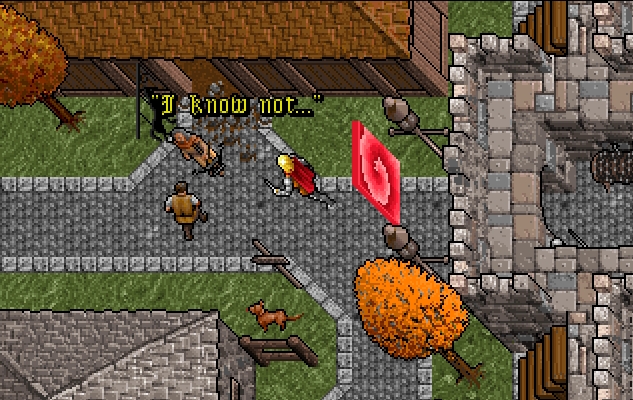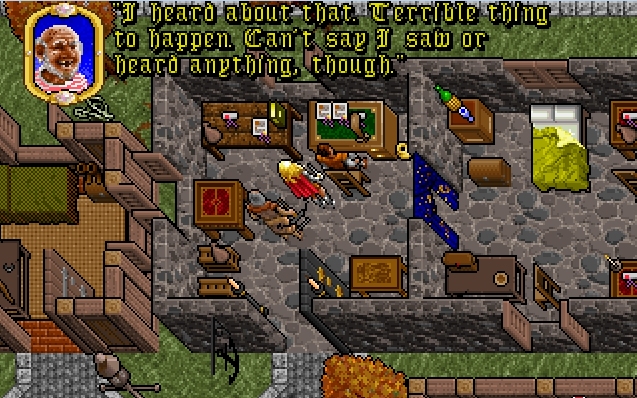This is the beginning of (hopefully) a series of posts that detail my experiences with an RPG I have often heard praised but never played: Ultima VII.
One of the hazards of playing older games is that you tend to run into paleolithic design elements that have, for better or worse, disappeared as games have become increasingly streamlined and user-friendly. To our modern gamer sensibilities, coddled as they are by elaborate in-game tutorials that hold our hands as they teach us to play the game — often infuriatingly integrated into the first half-hour of the campaign so that we are unable to avoid them — these design elements can often seem bizarre and unreasonable. We are no longer expected to Read The Manual; instead, a game should set the barrier to entry as low as it can in order to include as many people as possible. And if that results in the loss of some nuance and complexity from the overall design of the game, then so be it.
As a result, carrying out the videogame equivalent of archaeology can end up being a rather trying experience for any would-be Joneses. Not only do they have to learn the game in the same way as a contemporary player, but they’re also operating under a completely different paradigm. Games have moved on since then and anyone climbing into the time machine is likely to suffer from culture shock. Getting over that shock can be pretty difficult, sometimes. For some people it’s insurmountable and can lead to them wondering why on earth game X is regarded as such a classic. For the rest of us, it’s something we learn to live with.
I like to think that for someone whose family didn’t even own a PC until 1996 (my parents preferred Acorn computers for some reason), I have a reasonably high tolerance for games released before then. Back around 2003-04 I was suffering from a distinct lack of money combined with abundant free time, and so I resorted to trawling abandonware sites for my gaming kicks. I experienced the cliff-like difficulty of Buzz Aldrin’s Race into Space, the sprawling complexity of Emperor of Fading Suns, the incredibly primitive Windows graphics of Pirates! Gold, and in each of these cases I managed to make it past their various gameplay foibles to uncover the classic lurking beneath. I even got into Darklands for a time, a game with a stat screen that looks like a multinational corporation’s end of year financial return. I mention all this as a way as emphasising that when it comes to old games I’m fairly accomplished at putting up with hundred-plus page manuals, crappy UIs and dated control mechanisms. But in that two year period I never experienced anything like Ultima VII.
Ah, Ultima VII. It’s a game I have oft heard mentioned as one of the great classics of the RPG genre, but which Home of the Underdogs1 didn’t have in its database at the time I was carrying out my little expedition into gaming’s past. I always thought this was a shame, since a sprawling open world RPG with an insane level of interactivity is the sort of thing that would have been right up my alley. I mean just listen to this:
The gameworld of both games is renowned for its interactivity: virtually everything not nailed to the ground (and not excessively heavy) can be moved, taken, or interacted with in some fashion. It is possible, for instance, to bake bread, to forge weapons, to milk cows, to play musical instruments, and even to change a baby’s swaddling. The Avatar and his companions will complain of hunger pains and severe thirst, and will even die if these matters are not attended to eventually. If they come across a disgusting or gruesome scene, they may groan and vomit; strong alcoholic beverages may also induce vomiting.
I don’t know about you, but I’ve always wanted to play an RPG that let me change a baby’s nappy for no reason other than “Because I can”. So I was very happy when Good Old Games announced last year that they’d acquired the rights to some of the old Origin Software games; games which you could not find for love nor money on abandonware sites back in the day. They started out with Privateer and some of the earlier Ultima games, but I knew that if I waited long enough Ultima VII would crop up on their store page somewhere. And at the end of November my patience was rewarded.
It’s only now that I’ve gotten around to playing it, though, and after dabbling in it for thirty minutes I have discovered something that none of the glowing, nostalgia-laden reviews ever bothered to mention: Ultima VII features the control system from Hell. It’s the sort of control system that would count as revolutionary design when the game was released two decades ago, but since nobody bothered to continue the revolution it’s faded into history as one of gaming’s bizarre curios. The problem isn’t that Ultima VII has a bad UI with confusing buttons like so many older games. No, the problem is that Ultima VII doesn’t have a UI at all.
Everything in Ultima VII can be done via the mouse. Right clicking once moves the Avatar one pace. Right clicking twice causes the Avatar to path to the point where you clicked. Right clicking and dragging (what) moves the Avatar towards the mouse pointer. Left clicking examines an object. Double left clicking interacts with it. Left clicking and dragging picks the item up. Dropping the item on the Avatar moves it to their inventory. Since there’s no UI, how is the inventory accessed? Well, you double left click on the Avatar and a stats screen will pop up through which the inventory can be opened.
But wait. That’s an awful lot of actions to load onto a two-button interface. What if the Avatar is standing next to a door they want to open (by double left clicking) and the player accidentally clicks on the Avatar instead? The stats screen pops open and my blood pressure starts to rise. Same goes for when one of the companions who is constantly trailing the avatar — or even a random passer-by — wanders too close to whatever you’re trying to interact with. Trying to remember all the commands in-game is more than a little confusing, especially when the mouse pointer features no context-sensitive icons and isn’t all that discerning about what it thinks you want to click on. And I haven’t even gotten to the point of having to fight a combat yet, when I’ll have to do all this stuff under pressure. If Origin hadn’t included keyboard shortcuts for some of the actions I think this mouse-based control system would have been like that giant icy wall in HBO’s A Game Of Thrones — dauntingly huge and nigh-on impossible to scale. As it is I think it’s going to take a good couple of hours to get used to a control system that might as well have come from Mars2.
The good news is that the rest of the game seems to be exactly as advertised — vast, organic and utterly at the player’s mercy. I spent a few minutes last night just marvelling at the fact that every single NPC had about a dozen conversation topics with unique dialogue for all of them. There’s even a hilariously primitive dynamic weather system which is nonetheless impressive for 1992. So it looks like Ultima VII may be well worth spending an hour or two clambering over this wall for. I just wish it wasn’t there in the first place, is all.
- Experimental footnote system go! I could write a whole post about Home of the Underdogs, but these days it’s a sad shadow of its former self. Good Old Games is doing a very good job of offering many of the games that used to be on HOTU’s database for bargain prices, and if you really want to dip your toe into the legal grey area that is the abandonware scene then Abandonia is probably your best shot.
- If nothing else it’s a good window into what goes on in the head of a non-gamer when they try to play an FPS or a strategy game for the first time, and I promise I’ll be more patient with those people from now on.




Did you ever play Dwarf Fortress?
I ask because it is the single game that has inspired the most, and fiercest, debate over UI issues. It’s a bloated mess of a game now, of course, as as such has very few defenders, but there is still a divide between those who once thought it great and those who could never get past its Rogue-on-steroids interface.
Dwarf Fortress is a special case. The UI is bad. There’s no getting around that. But DF’s UI merely exacerbates the real issue with the game, which is that DF is possibly the most complex game ever made in terms of mechanics but it chooses to deal with the vast amount of information this complexity generates in pretty much the worst way imaginable. If you remade DF with a decent, mouse-driven UI and lots of pretty drop-down menus it’d still be nigh-unplayable for anyone unwilling to scale the Matterhorn-like learning curve involved in processing all this information, and it’d remain that way until somebody replaced the ASCII characters with some actual art and added an absolute *shitload* of tooltips to remind the player just what on earth is going on.
(I’m aware there’s custom tilesets for the game that add actual graphics, but the game isn’t really designed to cope with them. It’d need to be redesigned from the ground up to accommodate a true graphical interface.)